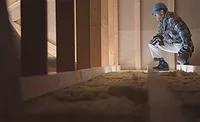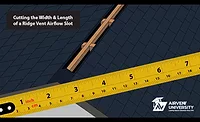Roofing Contractors 'Vent' About Homeowners
Air Vent asked roofing contractors to share the one message they’d like to say to a homeowner before arriving to inspect the roof and attic ventilation system.

“Think of attic ventilation as a prescription for good home health,” said Jeff Barnett, vice president of Barnett Roofing & Siding Inc. in Canton, Mich. “With proper ventilation, the home will breathe easier with less potential for mold and premature aging and failure of the roof system. Not to mention the reduced costs of operating the heating and cooling system.”

“Think of attic ventilation as a prescription for good home health,” said Jeff Barnett, vice president of Barnett Roofing & Siding Inc. in Canton, Mich. “With proper ventilation, the home will breathe easier with less potential for mold and premature aging and failure of the roof system. Not to mention the reduced costs of operating the heating and cooling system.”
A residential roofing contractor has met with a homeowner to review the proposed roofing estimate, which includes an attic ventilation assessment. What often happens next is a point of frustration for many quality-conscious contractors — strong resistance from the homeowner because of price, differences between other submitted roofing estimates, or the homeowner is unwilling to fully understand the project.
These and other “pain points” felt by contractors are voiced aloud during the popular Q&A session of Air Vent’s annual best practices in residential attic ventilation seminars. We asked contractors to share the one message they would like to say to a homeowner before arriving to inspect the roof and attic ventilation system.
It’s Necessary, Yet Neglected
The reason roofing contractors point out the attic ventilation system to a homeowner during a roof estimate is because it’s a required aspect in the overall roofing project. Attic ventilation directly impacts the performance and longevity of the roof. It helps to fight heat buildup inside the attic in the summer, moisture buildup in the winter, and it helps to fight ice dams in cold climates.
In our poll of residential roofing contractors across North America last spring, 77 percent of homes today have improper attic ventilation, including not enough or incorrect ventilation. It only makes sense, then, that the roofing contractor brings it up during the estimating process for a new roof.
“I want the homeowner to understand the need and purpose of a properly designed attic ventilation system,” said Matt Cooper, general manager at Redemption Roofing in Conroe, Texas. “The moisture we’re generating as occupants of the house in the winter needs to be vented. It will help extend the service life of the shingles.”
Corey Ballweg, owner of Mid Towne Construction Inc. in Cross Plains, Wis., had a similar message for homeowners.
“Get the maximum longevity from your new roof by having the attic properly ventilated,” Ballweg said. “You’ll also benefit from the energy savings associated with proper air movement in your attic.”
Clayton Putman, owner of Colorado Roofing Solutions in Aurora, Col., said it’s important that homeowners are familiar with the added value of a ventilated attic.
“I try to preach the benefits of an updated attic ventilation system: comfort, reduced cycling on big ticket items — like the HVAC system, furnace, swamp cooler, etc. — lower utility bills, longer shingle lifespan and maintaining the full terms of the shingle warranty,” Putman said. “My biggest selling point is comfort and reduced HVAC usage.”
If comfort and energy efficiency are not convincing, Greg Pike, project consultant at Campopiano Roofing in Twinsburg, Ohio, wants homeowners to know the following:
“You will not meet building code or the full terms of the shingle warranty requirements if the attic ventilation system is not correct,” he said.
Buying More Than Just a Roof
Contractors want homeowners to understand that the attic ventilation and the new roof go together, hand-in-hand.
“Please make sure you’re not just buying a roof. You need to buy a total system to prolong the life of your new roof, as well as other elements of your home,” said Sabrina Johnson, president of KDCO Home Improvement Inc. in Akron, Ohio.
Frequently, roofing contractors say, homeowners fail to grasp that the “system” Johnson is referring to is providing a financial payback.
“Attic ventilation gives you a return on investment better than any other ‘system’ within the roof assembly — lower electricity costs and extended roof life,” said Chris Arrington, vice president of Arrington Roofing in Dallas.
Jeff Barnett, vice president of Barnett Roofing & Siding Inc. in Canton, Mich., said homeowners should “think of attic ventilation as a prescription for ‘good home health.’”
“With proper ventilation, the home will breathe easier with less potential for mold and premature aging and failure of the roof system. Not to mention the reduced costs of operating the heating and cooling system,” Barnett said.
Believe the Research (if Not Me)
The roofing contractors who take the time to become familiar with the research that supports the benefits of attic ventilation should relay that to the homeowner.
“My message to homeowners is that many years of study have gone into learning about attic ventilation. We are trying to give homeowners the best possible roof system. This includes a lot more than just the roof covering they will see, but all the components that make a roof last,” said Richard Turner, owner of R. J. Turner Remodeling LLC in Winston Salem, N.C.
Patrick Readyhough, president of Pond Roofing Company Inc. in Fairfax, Va., said he explains to homeowners that “the manufacturer of the attic vents has done the research and testing, and this is absolutely necessary for the health of the entire home.”
Dale Johnson, general manager of Rock Solid Exteriors in Mount Clemens, Mich., has a saying he likes to share with customers: “Air tight isn’t necessarily right.”
“What I mean when I say this is that, because the living areas of homes are being designed or upgraded to be more air tight, it has a huge impact on the attic area as well as the roof system,” Johnson explained.
It certainly helps if the homeowner has a basic knowledge of the importance of attic ventilation prior to the roofing contractor’s arrival. To that end, J. R. Lynch, sales manager at Amos Exteriors in Indianapolis, points homeowners to helpful information readily available from ventilation manufacturers’ websites, brochures and apps.
Don’t Worry So Much About Price
It’s to be expected and it’s certainly the homeowner’s right to collect, compare and question the various roofing estimates submitted for the project. Buying a new roof is expensive and should be reviewed.
But just because the other contractors who have submitted estimates did not talk about attic ventilation does not make the contractor who did mention it wrong, misguided or overpriced.
“Attic ventilation is the most important part of a roof system. Don’t worry so much about the price. Worry about who is going to do the best work for your home,” said Sandra Daffer, owner of Hawaiian Built Roofing Inc. in Boise, Idaho.
For Ron Bastian, owner of Bastian Roofing in Richfield, Wis., he wants homeowners to know that he stands behind his craft, expertise and pricing. He wants homeowners who are comparing estimates to understand the following:
“We have been in business for 50 years doing our projects to their fullest, (and) each and every time attic ventilation is a must,” Bastian said.
Nevertheless, some homeowners will ask, “But why are you the only roofing contractor who discusses attic ventilation?” Bryan Epley, senior director of business development and sales at Gen 3 Roofing in Centennial, Colo., shares his response:
“Because only true roofing experts look at both the intake and exhaust ventilation when evaluating a roof system,” he said.
He adds that attic ventilation must be a balanced system of intake vents (in the soffit/overhang or low on the roof) and exhaust vents (at or near the roof peak) to perform at its best.
Sean Jegen, owner of Gorilla Exterior Contracting LLC in Shawnee, Kan., tells customers that “proper ventilation of your attic has a tight hold on the climate control and longevity of your roof system.”
“You need to have someone well versed in the ventilation expertise to properly address your home’s intake and exhaust airflow as best they can with what they have to work with on any given project,” Jegen said.
To the doubting homeowner, Christy Cummings, vice president of Cummings Roofing Inc. in Klamath Falls, Ore., points out the following:
“Our company has been trained in best practices and proper installation methods of products that come with warranties,” Cummings said.
As a testament to this dedication to training, Cummings drove five hours one way to attend the two-hour Air Vent seminar earlier in 2019.
Jeff Heitzenrater, president of operations at Triple Peaks Roofing and Construction Inc. in Olmsted Falls, Ohio, shares similar feelings about having his workforce properly trained and educated.
“Every chance we get we attend best practices seminars like Air Vent’s,” Heitzenrater said. “Not only (are we) learning during these seminars but (we’re) often taking phone calls from our competition because we firmly believe ‘Givers Gain’ — the more we ‘give’ to our industry, the more we ‘gain’ in knowledge. We’re bringing that knowledge to the homeowner.”
You’ll Learn Sooner or Later
Not every homeowner accepts the information presented by the roofing contractor. Some will reject the need to include or improve the attic ventilation in the project. To those homeowners, roofing contractors should offer a few words of caution.
“If you want it done wrong, call someone else,” said Trevor Atwell, owner of Atwell Exterior Services LLC in Greenville, N.C.
Sean Toms, quality control inspector at S & K Roofing in Eldersburg, Md., echoed this sentiment.
“Attic ventilation is a must! If you don’t listen you will learn sooner or later,” Toms said.
But if the homeowner understands and is willing to proceed with the project including attic ventilation, Sue May, owner of A Better Way Construction and Roofing LLC in Lincoln, Neb., just has one more message for the homeowner:
“Please clean out your closet or move the items so we can access the attic and do an inspection.”
Looking for a reprint of this article?
From high-res PDFs to custom plaques, order your copy today!







